Welcome to the Janison Academy help portal
Settings
In user settings it is possible make configurations related to your users. These setting manage the way users are viewed, added and edited in Manage People > Users. In addition, self registration forms and portfolio functionality can be activated and data sets added.

Navigate to Settings > User Settings to access these features.

There is a common section in several of the forms and views. This section provides options for administrators to configure the way fields are presented to users. Each form and view can be customised individually. For example, you can have date of birth visible on the create / edit form but hidden on the details view. Below are the forms and views containing the section. There are slight variations to the columns available per form and view.
Certain fields are mandatory by default. You will recognise these fields as they are greyed out and are not editable. Username is a common mandatory field.

 icon next to the field. On hover, the text you entered into this field will be displayed.
icon next to the field. On hover, the text you entered into this field will be displayed.
 icon on the form.
icon on the form. icon.
icon.
The above selections on the create / edit form will make creating a new user in Manage People > Users display like this. The fields marked with an are default mandatory fields set by the system.
are default mandatory fields set by the system.

There are several methods to add users to the system such as loading them via a spreadsheet or synchronising them from your HR system. This method allow users to self-register on your site. By default this option is disabled. This section also provides options to customise the way users register.

The fields of the self registration form can be customised in many ways. Fields can be make visible or hidden and set to mandatory where required. They can be capitalised and the order in which they appear changed. Captions can be set to change the default system wording. You can read more about this topic in our document on configuring fields.

Two methods are available for self-registration and are covered in more detail below:

Selecting this option will add a Register link to the login screen.

When a user selects this link, they will be directed to a Sign Up screen.

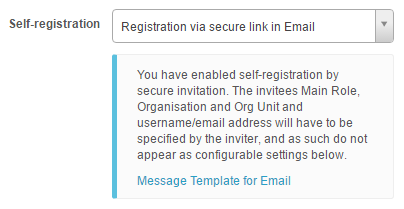
You can invite up to 30 users at a time to self-register by emailing them a secure link.
To send the secure link navigate to Manage People > Users.
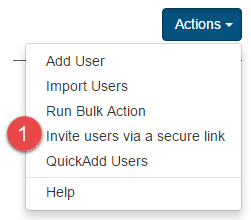
You will be directed to the Invite users via a secure link screen.

When a user selects the link in the email, they will be directed to a Sign Up screen.


Email validation ensures that only users with a valid email addresses can register. On sign-up, the user will receive a registration confirmation email with a link to activate their account and to set a password. Selecting the option to skip validation will bypass the email validation and sign the user directly into the site.

The system can generated passwords for users but you would only set this option under special circumstances such as in assessment events. This option is only valid if password generation has been enabled. You can read more about this topic in our document on password generation.

It will only be possible for users to register if their email belongs to domains entered into this field. In the example below, janison.com.au has been set as an allowed email mask. jira.com.au therefore does not meet the requirement. Wildcards * are permitted, for example, *.com.au restricts email addresses to those that end in .com.au.

You can specify the format in which the system will generated usernames. You can set it to use email addresses or combinations of the first and last name.
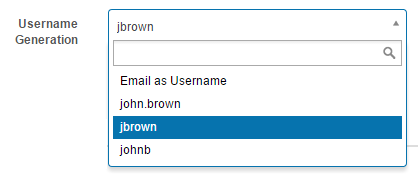
By default, users will be assigned the role of basic user. You can customise this to another role if required. Note that for security reasons, in-built system administrator roles are not available for selection.

The fields of the registration form can be customised in many ways. Fields can be make visible or hidden and set to mandatory where required. They can be capitalised and the order in which they appear changed. Captions can be set to change the default system wording. You can read more about this topic in our document on configuring fields.

The system can check to ensure that either emails or last names are unique or that a combination of the two is unique.

If the email and or last name exists in the system, feedback will be provided to the user.

It is possible to add users to groups and then to enrol them into catalogue items, all automatically on self registration. For example, you can add an age range selector to your registration page. You can then set the system to enrol users into courses, depending on the age range they selected on registration.

There are a number of steps involved in setting up this process.
Set up a group type and add your groups. You can read more about the steps to undertake this task in our document on group types.

Set the group type to appear on the self-registration form.

Navigate to your site login page and select the Register link to view your registration form. The group type will appear as a dropdown with the age ranges as selectable items.

Set up a user enrolment rule which will trigger automatic enrolments into the catalogue Items. You can read about this topic and the steps in out document on user enrolment rules.
Your user enrolment rule will look something like this. You will need one rule for each age range as each age range will be enrolled into a different course relevant to their age.

This section provides options to customise the screens in Manage People > Users where new users are created and existing users are edited.
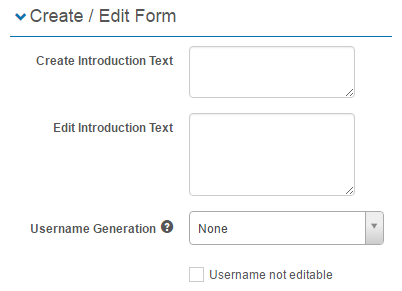
This is the new user screen with just a few fields set to visible.
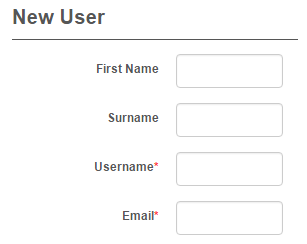
The introduction text provides the facility to add custom text which will be displayed to administrators when they create new users.

The introduction text will be displayed in the snippet on the new user screen.
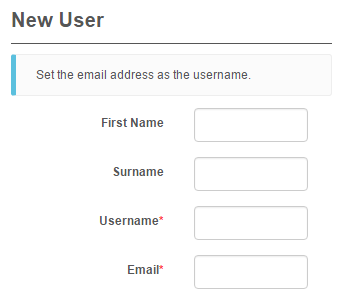
This field provides the facility to add custom text which will be displayed to administrators when they edit a user.

The introduction text will be displayed in the snippet on the edit user screen.
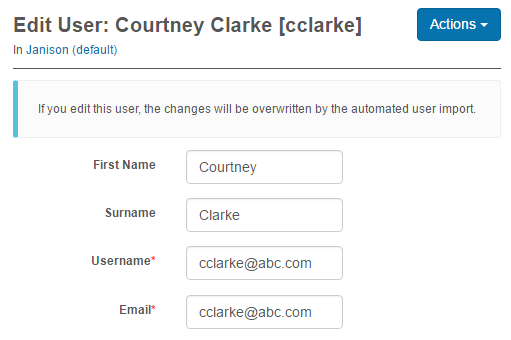
You can specify the format in which the system will generated usernames. You can set it to use email addresses or combinations of the first and last name.
Usernames will be generate when the new user save button is selected.

If selected, editing of usernames will not be possible.

When in user edit mode, the username field will be locked.

The fields of the new user and edit form can be customised in many ways. Fields can be make visible or hidden and set to mandatory where required. They can be capitalised and the order in which they appear changed. Captions can be set to change the default system wording. You can read more about this topic in our document on configuring fields.

This section provides options to customise the users list screen in Manage People > Users.

This is the users list view with only four columns set visible, Name, Username, Email & Actions.

This field provides the facility to add custom text which will be displayed to administrators when they view the user list.

The introduction text will be displayed in the snippet on the user list screen.
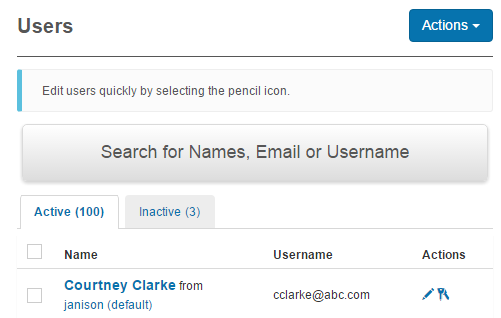
The fields of the list view can be customised in many ways. Fields can be make visible or hidden and the order in which they appear changed. Captions can be set to change the default system wording. You can read more about this topic in our document on configuring fields.
An additional column is available in list view, batch edit.
This feature is only applicable to custom attribute fields. It provides functionality to update information for one or more users. There are a several steps involved to set this up.
Step one: Create a custom attribute of a string type and linked objects of users. You can read more about this topic in our document on custom attributes.

Step two: In the list view section, select Batch Edit for the new custom attribute. Save the section.
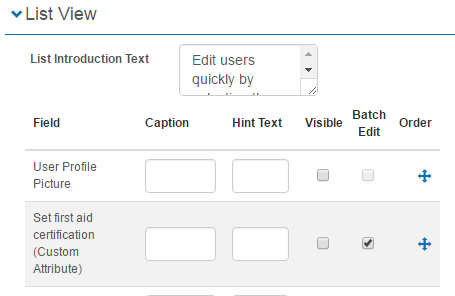
Step three: Action the batch edit on the users list screen.
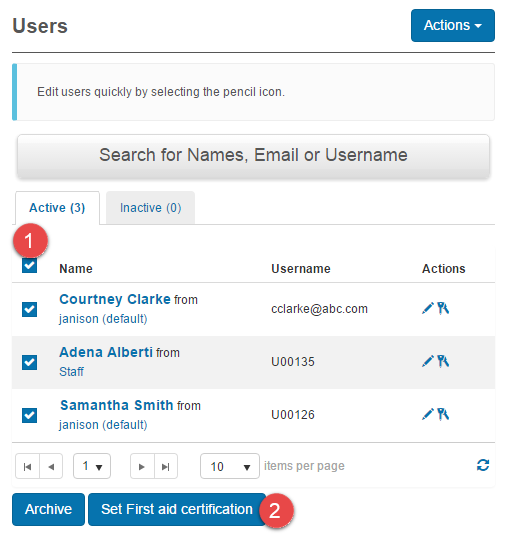

Step four: View the attribute you have just set. Remember that you can set this to visible on any of your views or forms as described in our document on configuring fields. In the example below it is visiable on the details view.
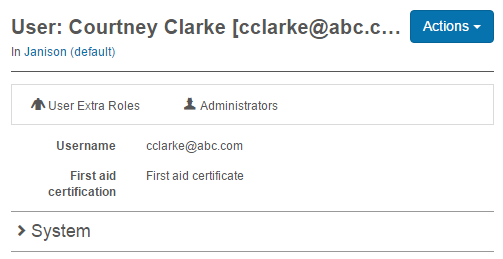
This section provides options to customise an individual users details screen in Manage People > Users.

This is the screen affected.

These settings control the visibility of sections on the user details screen.

To access a user details screen, browse to Manage People > Users and select a user from the list.
This setting makes a section visible that will list catalogue item enrolments, but only if the catalogue items have small thumbnails linked. If a catalogue item has a certificate attached, it can be access here by selecting the image icon.

This setting makes a section visible that lists all purchases made by the user. If purchases have been made, a link will be displayed and when selected will direct you to the orders.

This setting makes two sections visible detailing activities performed by the user and on the user record.


This setting makes a section visible listing the roles of the user.

Each User in the system has a personal details tile which is can be found by navigating to Manage People > People. The information displayed on this tile can be configured in this setting menu.
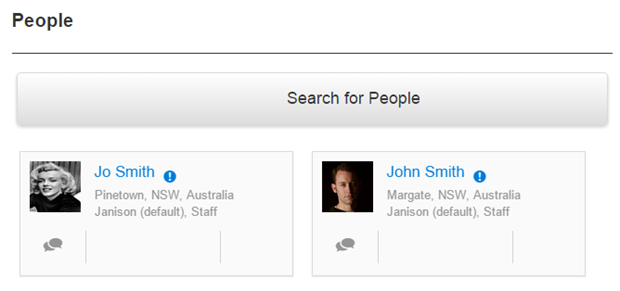



The default user settings includes two drop-down menus.

1300 857 687 (Australia)
+61 2 6652 9850 (International)
ACN 091 302 975
ABN 35 081 897 494
© 2024 Janison
Janison acknowledges the traditional owners of the land on which we work and meet. We acknowledge the continuous care of the land, animals and waterways. We pay our respects to Elders past, present and emerging.